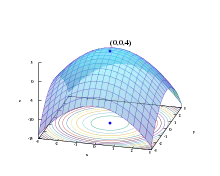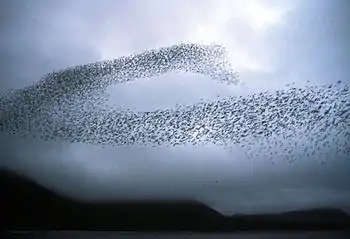Firefly algorithm
In mathematical optimization, the firefly algorithm is a metaheuristic proposed by Xin-She Yang and inspired by the flashing behavior of fireflies.[1]
Algorithm
In pseudocode the algorithm can be stated as:
Begin
1) Objective function: ;
2) Generate an initial population of fireflies ;.
3) Formulate light intensity I so that it is associated with
(for example, for maximization problems, or simply ;)
4) Define absorption coefficient γ
While (t < MaxGeneration)
for i = 1 : n (all n fireflies)
for j = 1 : i (n fireflies)
if (),
Vary attractiveness with distance r via ;
move firefly i towards j;
Evaluate new solutions and update light intensity;
end if
end for j
end for i
Rank fireflies and find the current best;
end while
Post-processing the results and visualization;
end
Note that the number of objective function evaluations per loop is one evaluation per firefly, even though the above pseudocode suggests it is n×n. (Based on Yang's MATLAB code.) Thus the total number of objective function evaluations is (number of generations) × (number of fireflies).
The main update formula for any pair of two fireflies and is
where is a parameter controlling the step size, while is a vector drawn from a Gaussian or other distribution.
It can be shown that the limiting case corresponds to the standard Particle Swarm Optimization (PSO). In fact, if the inner loop (for j) is removed and the brightness is replaced by the current global best , then FA essentially becomes the standard PSO.
Criticism
Nature-inspired metaheuristics in general have attracted criticism in the research community for hiding their lack of novelty behind an elaborate metaphor. The firefly algorithm has been criticized as differing from the well-established particle swarm optimization only in a negligible way.[2][3][4]
See also
References
- Yang, X. S. (2008). Nature-Inspired Metaheuristic Algorithms. Luniver Press. ISBN 978-1-905986-10-1.
- Almasi, Omid N.; Rouhani, Modjtaba (2016). "A new fuzzy membership assignment and model selection approach based on dynamic class centers for fuzzy SVM family using the firefly algorithm". Turkish Journal of Electrical Engineering & Computer Sciences. 4: 1–19. doi:10.3906/elk-1310-253.
Practical application of FA on UCI datasets.
- Lones, Michael A. (2014). "Metaheuristics in Nature-Inspired Algorithms" (PDF). GECCO '14: 1419–1422. CiteSeerX 10.1.1.699.1825. doi:10.1145/2598394.2609841. ISBN 9781450328814.
FA, on the other hand, has little to distinguish it from PSO, with the inverse-square law having a similar effect to crowding and fitness sharing in EAs, and the use of multi-swarms in PSO.
- Weyland, Dennis (2015). "A critical analysis of the harmony search algorithm—How not to solve sudoku". Operations Research Perspectives. 2: 97–105. doi:10.1016/j.orp.2015.04.001.
For example, the differences between the particle swarm optimization metaheuristic and "novel" metaheuristics like the firefly algorithm, the fruit fly optimization algorithm, the fish swarm optimization algorithm or the cat swarm optimization algorithm seem negligible.
External links
- Files of the Matlab programs included in the book: Xin-She Yang, Nature-Inspired Metaheuristic Algorithms, Second Edition, Luniver Press, (2010).


